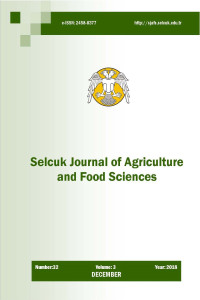Effect of Tillage Systems on Chickpea (Cicer arietinum L.) Productivity: Seed Yield and Yield Components
Öz
This research was conducted at the experimental field of Polatli Agricultural farms to the General Directorate of Farm Enterprises (TIGEM) in 2008 and 2009 for determination the effect of four different tillage systems on yield and yield components of a chickpea (Cicer arietinum L.) variety under Central Anatolian conditions of Turkey. Traditional, minimum (reduced), no-till (direct seeding) and no-till + herbicide treatments were applied in the experiment. According to the results of the research tillage systems constituted significant differences for seed yield, plant height, legume number per plant, biological yield per plant, harvest index and 1000-seed weight. Average seed yield values of chickpea in the traditional, minimum, no-till and no-till + herbicide treatments were 1558.25 kg.ha-1, 1240.10 kg.ha-1, 1637.30 kg.ha-1 and 1874.85 kg.ha-1, respectively. Relationships between yields’ data and tillage systems were R2=0.469** and 0.412** indicating a significant influence of tillage systems. In this way, the results revealed that direct seeding can be offered for chickpea cultivation in Central Anatolian Region.
Anahtar Kelimeler
Ayrıntılar
| Birincil Dil | İngilizce |
|---|---|
| Konular | Agronomi |
| Bölüm | Araştırma Makalesi |
| Yazarlar | |
| Yayımlanma Tarihi | 28 Aralık 2018 |
| Gönderilme Tarihi | 3 Eylül 2018 |
| Yayımlandığı Sayı | Yıl 2018 Cilt: 32 Sayı: 3 |
Selcuk Journal of Agriculture and Food Sciences Creative Commons Atıf-GayriTicari 4.0 Uluslararası Lisansı (CC BY NC) ile lisanslanmıştır.


